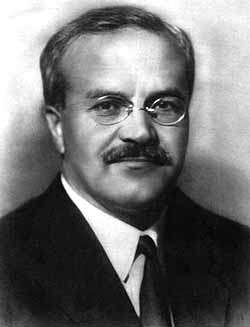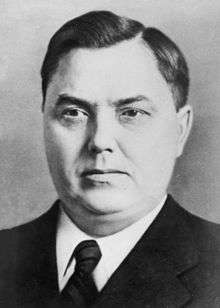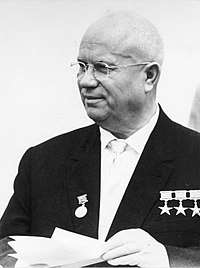Premier of the Soviet Union
| Premier of the Soviet Union Глава Правительства СССР | |
|---|---|
|
| |
| Residence | Grand Kremlin Palace, Moscow |
| Precursor | Chairman of the Council of People's Commissars of the RSFSR |
| Formation | 30 December 1922 |
| First holder | Vladimir Lenin |
| Final holder | Ivan Silayev |
| Abolished | 25 December 1991 |
| Succession | Prime Minister of the Russian Federation |
The office of Premier of the Soviet Union (Russian: Глава Правительства СССР) was synonymous with head of government of the Union of Soviet Socialist Republics (USSR). Twelve individuals became premier over the time span of the office. Two of the twelve premiers died in office of natural causes (Vladimir Lenin and Joseph Stalin), three resigned (Alexei Kosygin, Nikolai Tikhonov and Ivan Silayev), and three held the offices of party leader and premier simultaneously (Lenin, Stalin and Nikita Khrushchev). The first premier was Lenin, who was inaugurated in 1922 after the Treaty on the Creation of the USSR. Ivan Silayev spent the shortest time in office at 126 days in 1991. At over fourteen years, Kosygin spent the longest time in office, and became the only premier to head more than two government cabinets; he died shortly after his resignation in 1980.
The Council of People's Commissars (Sovnarkom) was established on 8 November 1917 by the Russian Soviet Federative Socialist Republic (RSFSR) Government. Article 38 of the 1924 Soviet Constitution stated that the Council's powers, functions and duties were given to it by the Central Executive Committee (CEC) which supervised the Council's work and legislative acts. The Council of People's Commissars published decrees and decisions that were binding throughout the Soviet Union.[1] In 1946, the Council of People's Commissars was transformed into the Council of Ministers (Sovmin) at both all-Union and Union Republic level.[2]
In 1964, after Nikita Khrushchev's ouster, a plenum of the Central Committee (CC) forbade any single individual to hold the two most powerful posts of the country (the office of the General Secretary and the premier),[3] and Kosygin was in charge of economic administration in his role as Chairman of the Council of Ministers. However Kosygin's position was weakened when he proposed an economic reform in 1965.[4] Under the 1977 Soviet Constitution, the Chairman of the Council of Ministers was the head of government of the USSR. The premier was the chief of the executive branch and head of the union government as a whole, the premiership was the highest governmental office in the Soviet Union by influence and recognition until the establishment of the Presidency in 1990. The premier was responsible and accountable to the Supreme Soviet, and in the period between sessions of the Supreme Soviet, accountable to the Presidium of the Supreme Soviet.[5] The premier was tasked with resolving all state administrative duties within the jurisdiction of the USSR to the degree that it did not come under the competence of the Supreme Soviet or the Presidium. The premier managed the national economy, formulated the five-year plans and ensured socio-cultural development.[6]
When Nikolai Ryzhkov was replaced as premier by Valentin Pavlov, the Council of Ministers was dissolved and replaced by the Cabinet of Ministers, while the chairmanship was replaced by the office of Prime Minister of the Soviet Union. After the failed August Coup of 1991, and the revelation that the majority of the cabinet members supported the coup, the Cabinet of Ministers was dissolved and replaced by the Committee on the Operational Management of the Soviet economy in 1991. The Operational Management Committee was renamed the Inter-Republican Economic Committee,[7] and was later replaced by the Interstate Economic Committee (IEC), the IEC was also officially known as the Economic Community.[8]
List of Premiers
| # [note 1] |
Name (birth–death) |
Tenure | Electorate | Cabinets | ||
|---|---|---|---|---|---|---|
| 1 | Chairman of the Council of People's Commissars (1922–46) | |||||
| Vladimir Lenin (1870–1924)[9] |
 |
30 December 1922 – 21 January 1924 | — | Lenin I–II | ||
| Regarded as the first Soviet Premier; led the Russian Social Democratic Labour Party (RSDLP) through the Russian Revolution (February and October Revolution)[10] and successfully created the world's first socialist state, the Russian Socialist Federative Soviet Republic (RSFSR),[11] and established the Soviet Union in 1922.[12] | ||||||
| 2 | Alexei Rykov (1881–1938)[13] |
 |
2 February 1924 – 19 December 1930 | 1924, 1925, 1927, 1929 | Rykov I | |
| A member of the moderate faction within the Bolshevik Party. He was forced, along with other moderates, to "admit their mistakes" to the party and, in 1930, Rykov lost his premiership because of it.[14] | ||||||
| 3 | Vyacheslav Molotov (1890–1986)[15] |
 |
19 December 1930 – 6 May 1941 | 1931, 1935, 1936, 1937 | Molotov I | |
| He oversaw Stalin's collectivization of agriculture, the implementation of the First Five-Year Plan, industrialisation of the USSR and the Great Purge of 1937–38.[16] Despite the great human cost,[17] the Soviet Union under Molotov's nominal premiership made great strides in the adoption and widespread implementation of agrarian and industrial technology.[18] | ||||||
| 4 | Joseph Stalin (1878–1953)[19] |
 |
6 May 1941 – 15 March 1946 | 1946 | Stalin I | |
| Led the country through the Great Patriotic War (World War II) and started the country's reconstruction period. He renamed the office of the People's Commissars to the Council of Ministers.[20] | ||||||
| Chairman of the Council of Ministers (1946–1991) | ||||||
| Joseph Stalin (1878–1953)[19] |
 |
15 March 1946 – 5 March 1953 | 1950 | Stalin II | ||
| After the war, Stalin installed communist governments in most of Eastern Europe, forming the Eastern Bloc,[20] behind what was referred to as an "Iron Curtain" of Soviet rule during the long period of antagonism between the Western world and the USSR, known as the Cold War.[21] | ||||||
| 5 | Georgy Malenkov (1902–1988)[22] |
 |
6 March 1953 – 8 February 1955 | 1954 | Malenkov I–II | |
| Took over after Stalin's death, but lost in the ensuing power struggle against Nikita Khrushchev. He continued to hold the office of premier until Khrushchev started the process of de-Stalinisation. He was replaced on Khrushchev's orders by Nikolai Bulganin.[23] | ||||||
| 6 | Nikolai Bulganin (1895–1975)[24] |
 |
8 February 1955 – 27 March 1958 | 1958 | Bulganin I | |
| Oversaw the period of de-Stalinisation.[25] While being a strong supporter of Khrushchev at first, he started doubting some of his more radical policies and, accused of being a member of the Anti-Party Group, was eventually replaced by Khrushchev himself.[26] | ||||||
| 7 | Nikita Khrushchev (1894–1971)[22] |
 |
27 March 1958 – 14 October 1964 | 1962 | Khrushchev I–II | |
| Led the country through the Cuban Missile Crisis. Oversaw numerous reforms and policy innovations, such as the 1961 monetary reform. His increasingly erratic behaviour led to his removal by the nomenklatura both as premier and First Secretary of the Communist Party.[25] | ||||||
| 8 | Alexei Kosygin (1904–1980)[27] |
 |
15 October 1964 – 23 October 1980 | 1966, 1970, 1974, 1979 | Kosygin I–V | |
| Was one of three leading members of the collective leadership with Leonid Brezhnev and Nikolai Podgorny. He ruled through the era known as the Era of Stagnation.[4] Kosygin initiated three large scale economic reforms under his leadership; the 1965, the 1973–74 and the 1979 reform.[28] He retired from office in October 1980 and died two months later.[29] | ||||||
| 9 | Nikolai Tikhonov (1905–1997)[30] |
23 October 1980 – 27 September 1985 | 1984 | Tikhonov I–II | ||
| After Kosygin's departure, Tikhonov became the new premier;[31] he held the office through Brezhnev's last years, the rules of Yuri Andropov and Konstantin Chernenko and the very beginning of Mikhail Gorbachev's tenure.[32] | ||||||
| 10 | Nikolai Ryzhkov (born 1929)[30] |
 |
27 September 1985 – 14 January 1991 | 1989 | Ryzhkov I–II | |
| Ryzhkov supported Gorbachev's attempt to revive and restructure the Soviet economy through decentralising planning and introducing new technology. However, he resisted Gorbachev's later attempts to introduce market mechanisms into the Soviet economy.[33] He was forced to resign when his office as Chairman of the Council of Ministers was dissolved.[34] | ||||||
| 11 | Prime Minister of the Soviet Union (1991) | |||||
| Valentin Pavlov (1937–2003)[35] |
14 January 1991 – 22 August 1991 | — | Pavlov I | |||
| Pavlov was elected to the new position of Prime Minister as a compromise candidate. He carried out a highly unsuccessful monetary reform which failed[36] and led him to join the State Committee of the State of Emergency. The State Committee attempted to depose Gorbachev on 19 August. With the collapse of the coup, Pavlov was arrested on 29 August.[37] | ||||||
| 12 | Chairman of the Interstate Economic Committee – Prime Minister of the Economic Commonwealth (1991) | |||||
| Ivan Silayev (born 1930)[38] |
— | 6 September 1991 – 26 December 1991 | — | Silayev I | ||
| After the August Coup of 1991, the Soviet government lost much of its power over the republics. Silayev was unable, together with Gorbachev, to hold the Soviet state together which eventually led to its demise.[39] | ||||||
See also
 |
| This article is part of a series on the politics and government of the Soviet Union |
|
Judiciary |
- List of heads of state of the Soviet Union
- List of leaders of the Soviet Union
- Deputy Premier of the Soviet Union
- First Deputy Premier of the Soviet Union
Sources
Notes
- ↑ These numbers are not official.
References
- ↑ Центральный Исполнительный Комитет съезда Советов. Статья №38 от Декабрь 1977 «Суверенные права союзных республик». (Central Executive Committee of the Congress of Soviets. Article #38 of December 1924 Sovereign Rights of the Member Republics. ).
- ↑ "О преобразовании Совета Народных Комиссаров СССР в Совет Министров СССР и Советов Народных Комиссаров Союзных и Автономных республик в Советы Министров Союзных и Автономных республик" 15 марта 1946 года [On Reforming the Council of People's Commissars into the Council of Ministers of the USSR, and the Councils of People's Commissars of Union and Autonomous Republics into the Councils of Ministers of Union and Autonomous Republics, 15 March 1946]. Legislation of the USSR 1946-1952 (in Russian). World and Market Economy - Collection of Articles on Economy, Igor Averin. Retrieved 3 October 2010.
- ↑ Service 2009, p. 378.
- 1 2 Brown 2009, p. 403.
- ↑ Верховный Совет СССР. Федеральный конституционный закон №130 от 7 октября 1977 «Совета Министров СССР». (Supreme Soviet of the Soviet Union. Article #130 of 7 October 1977 The Council of Ministers of the USSR. ).
- ↑ Верховный Совет СССР. Федеральный конституционный закон №131 от 7 октября 1977 «Совета Министров СССР». (Supreme Soviet of the Soviet Union. Article #131 of 7 October 1977 The Council of Ministers of the USSR. ).
- ↑ Ferdinand 1993, pp. 163–164.
- ↑ Ferdinand 1993, p. 133.
- ↑ Cull, Culbert & Welch 2003, p. 182.
- ↑ Young & Braden 2005, p. 40.
- ↑ Service 2000, p. 1.
- ↑ Образование СССР (in Russian). Hrono.info. Retrieved 24 September 2010.
- ↑ Phillips 2000, p. 82.
- ↑ Rappaport 1999, pp. 238–39.
- ↑ Phillips 2000, p. 89.
- ↑ Fainsod & Hough 1979, p. 295.
- ↑ Sebag-Montefiore 2005, p. 125.
- ↑ Sebag-Montefiore 2005, p. 236.
- 1 2 Totten & Bartrop 2008, p. 76.
- 1 2 Service 2005, pp. 3–4.
- ↑ Service 2005, p. 503.
- 1 2 Duiker & Spielvogel 2006, p. 572.
- ↑ Coppa 2006, pp. 170–71.
- ↑ Trahair & Miller 2004, p. 69.
- 1 2 Gorbachev, Mikhail (26 April 2007). "The First Steps Towards a New Era". The Guardian. Retrieved 4 September 2010.
- ↑ Coppa 2006, p. 38.
- ↑ Trahair & Miller 2004, p. 37.
- ↑ ютуба, любитель (17 December 2010). "30 лет назад умер Алексей Косыгин" [A reformer before Yegor Gaidar? Kosygin died for 30 years ago]. Newsland (in Russian). Retrieved 3 January 2011.
- ↑ Вергасов, Фатех. Организация здорового накала (in Russian). pseudology.org. Retrieved 4 September 2010.
- 1 2 Ploss 2010, p. 219.
- ↑ Zemtsov 1989, p. 119.
- ↑ Service 2009, pp. 403–4.
- ↑ Garcelon 2005, pp. 128–29.
- ↑ Harris 2005, p. 133.
- ↑ Валентин Сергеевич Павлов [Valentin Sergeyevich Pavlov] (in Russian). RU: Hrono. Retrieved 6 December 2010.
- ↑ Dyker 1992, pp. 207–8.
- ↑ Bonnell & Cooper 1994, pp. 63–64.
- ↑ Иван Степанович Силаев [Ivan Stepanovich Silayev] (in Russian). RU: Hrono. Retrieved 6 December 2010.
- ↑ Kotz & Weir 2007, p. 122.
Bibliography
- Brown, Archie (2009). The Rise & Fall of Communism. Bodley Head. ISBN 978-0061138799.
- Bonnell, Victoria; Cooper, Ann (1994). Russia at the Barricades: Eyewitness Accounts of the August 1991 coup. M.E. Sharpe. ISBN 978-1563242717.
- Coppa, Frank (2006). Encyclopedia of Modern Dictators: From Napoleon to the Present. Peter Lang. ISBN 978-0820450100.
- Cull, Nicholas; Culbert, David; Welch, David (2003). Propaganda and Mass Persuasion: A Historical Encyclopedia, 1500 to the Present. ABC-CLIO. ISBN 978-1576078204.
- Duiker, William; Spielvogel, Jackson (2006). The Essential World History. Cengage Learning. ISBN 978-0495902270.
- Dyker, David (1992). Restructuring the Soviet economy (1st ed.). Routledge. ISBN 978-0415067614.
- Fainsod, Merle; Hough, Jerry F. (1979). How the Soviet Union is Governed. Harvard University Press. ISBN 978-0674410305.
- Ferdinand, Maria Feldbrugge Joseph (1993). Russian Law: The End of the Soviet System and the Role of Law (1st ed.). Springer Publishing. ISBN 978-0792323587.
- Garcelon, Marc (2005). Revolutionary Passage: From Soviet to Post-Soviet Russia, 1985–2000. Temple University Press. ISBN 978-1592133628.
- Harris, Jonathan (2005). Subverting the System: Gorbachev's Reform of the Party's Apparat, 1986–1991. Rowman & Littlefield. ISBN 978-0742526792.
- Kotz, David Michael; Weir, Fred (2007). Russia's Path from Gorbachev to Putin: The Demise of the Soviet System and the New Russia (2nd ed.). Taylor & Francis. ISBN 978-0415701471.
- Phillips, Steven. Lenin and the Russian Revolution. Heinemann. ISBN 978-0-435-32719-4.
- Ploss, Sidney (2010). The Roots of Perestroika: The Soviet Breakdown in Historical Context. McFarland & Company. ISBN 978-0786444861.
- Rappaport, Helen (1999). Joseph Stalin: A Biographical Companion. ABC-CLIO. ISBN 978-1576070840.
- Sebag-Montefiore, Simon (2005). Stalin: The Court of the Red Tsar. Vintage Books. ISBN 978-1400042302.
- Service, Robert (2000). Lenin: A Biography. Belknap Press of Harvard University Press. ISBN 978-0674008281.
- Service, Robert (2009). History of Modern Russia: From Tsarism to the Twenty-first Century. Penguin Books Ltd. ISBN 978-0674034938.
- Service, Robert (2005). Stalin: A Biography. Harvard University Press. ISBN 978-0674016972.
- Totten, Samuel;; Bartrop, Paul (2008). Dictionary of Genocide: A–L. 1. Greenwood Publishing Group. ISBN 978-0313346422.
- Trahair, Richard;; Miller, Robert (2004). Encyclopedia of Cold War Espionage, Spies, and Secret Operations. Greenwood Publishing Group. ISBN 978-1929631759.
- Young, Gregory; Braden, Nate (2005). The Last Sentry: The True Story That Inspired the Hunt for Red October. Naval Institute Press. ISBN 978-1591149927.
- Zemtsov, Ilya (1989). Chernenko, the Last Bolshevik: The Soviet Union on the eve of Perestroika. Transaction Publishers. ISBN 978-0887382604.
